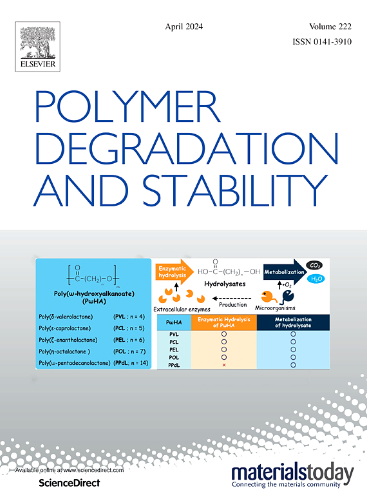Depolymerisation of polyisoprene by olefin cross-metathesis at equilibrium
IF 6.3
2区 化学
Q1 POLYMER SCIENCE
引用次数: 0
Abstract
Chemical valorisation of polymers gained a massive interest in the recent years, as it represents a more sustainable approach for the management of plastic waste. In particular, depolymerisation of polydienes by olefin cross metathesis is a powerful strategy to access telechelic oligomers with a variety of end groups. Despite the multiplication of investigations aimed at developing new materials from these oligomers, there has been little interest in the prediction of their molecular weight after depolymerisation, even though it represents a major parameter influencing macromolecular properties; in fact, most studies only rely on a kinetic approach to obtain a targeted molar mass. Here, we demonstrate that the equilibrium molecular weight of the oligodienes can be calculated from the amount of chain-transfer agent incorporated in the polymer. Equilibrium was achieved by performing several additions of catalyst, and the molar mass could be predicted from a simple statistical model. While we could not predict the conversion of chain-transfer agent beforehand, this statistical approach still provides an easy tool to establish the degree of polymerization of the products and, hence, have a better control over the final materials properties.
在平衡状态下烯烃交叉复分解聚异戊二烯的解聚合
近年来,聚合物的化学增值获得了巨大的兴趣,因为它代表了一种更可持续的塑料废物管理方法。特别是,通过烯烃交叉复合反应的聚二烯解聚是获得具有各种端基的远旋低聚物的有力策略。尽管从这些低聚物中开发新材料的研究越来越多,但对解聚后其分子量的预测几乎没有兴趣,尽管它是影响大分子性质的主要参数;事实上,大多数研究仅依靠动力学方法来获得目标摩尔质量。在这里,我们证明了低聚二烯的平衡分子量可以通过加入链转移剂的量来计算。通过多次添加催化剂达到平衡,摩尔质量可以通过简单的统计模型预测。虽然我们不能事先预测链转移剂的转化,但这种统计方法仍然提供了一种简单的工具来确定产物的聚合程度,从而更好地控制最终材料的性能。
本文章由计算机程序翻译,如有差异,请以英文原文为准。
求助全文
约1分钟内获得全文
求助全文
来源期刊

Polymer Degradation and Stability
化学-高分子科学
CiteScore
10.10
自引率
10.20%
发文量
325
审稿时长
23 days
期刊介绍:
Polymer Degradation and Stability deals with the degradation reactions and their control which are a major preoccupation of practitioners of the many and diverse aspects of modern polymer technology.
Deteriorative reactions occur during processing, when polymers are subjected to heat, oxygen and mechanical stress, and during the useful life of the materials when oxygen and sunlight are the most important degradative agencies. In more specialised applications, degradation may be induced by high energy radiation, ozone, atmospheric pollutants, mechanical stress, biological action, hydrolysis and many other influences. The mechanisms of these reactions and stabilisation processes must be understood if the technology and application of polymers are to continue to advance. The reporting of investigations of this kind is therefore a major function of this journal.
However there are also new developments in polymer technology in which degradation processes find positive applications. For example, photodegradable plastics are now available, the recycling of polymeric products will become increasingly important, degradation and combustion studies are involved in the definition of the fire hazards which are associated with polymeric materials and the microelectronics industry is vitally dependent upon polymer degradation in the manufacture of its circuitry. Polymer properties may also be improved by processes like curing and grafting, the chemistry of which can be closely related to that which causes physical deterioration in other circumstances.
 求助内容:
求助内容: 应助结果提醒方式:
应助结果提醒方式:


